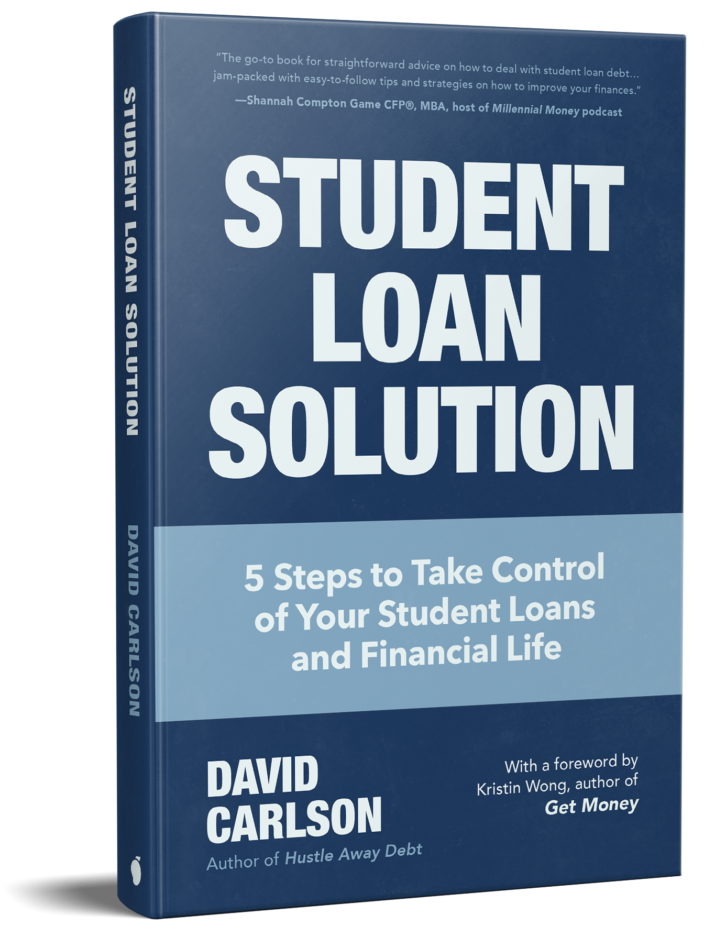 There are many things you can do this year to improve your financial life.
There are many things you can do this year to improve your financial life.
You can start or add to an existing emergency fun. You can invest in a retirement account. You can budget.
This year I want to encourage you to take a specific money challenge: take control of your student loan debt.
Everyone’s situation is different. People take out different amounts of student loans, at different interest rates, for different degrees.
Some people finish school, some do not. Income can vary drastically for grads and non-grads alike.
For some borrowers, student loans are no big deal. They only have a small amount of debt and they pay it off either over the standard ten-year repayment period or faster than ten years.
This isn’t the norm, though. For many student loans are a huge burden. It can seem like an insurmountable task to pay them off. It may be difficult to ever imagining paying them off.
It’s no surprise that student loans consistently hold people back financially and cause mental health issues like depression. More than a million borrowers default for the first time each year.
Regardless of your personal situation, if you have student loans you can benefit from taking specific actions that give you a feeling of control over them.
If you don’t have a full understanding of your student loans, your repayment options, and what the best strategy is for maximizing your financial life, I encourage you to take part in a money challenge: take control of your student loans.
Here’s specifically what I think you should do to take control of your student loans:
- Understand your Student Loans – If you don’t know what loans you have, how much you have in loans, and what interest rate your loans are at, the first step is to find out. You can use my free student loan spreadsheet to do that. The next step is to understand what things like Direct Subsidized, FFEL Unsubsidized, and other student loan terms mean.
- Understand your Repayment Options – The standard ten-year repayment option isn’t the only repayment option; there are income-driven repayment options that will limit your required monthly payment depending on your income level. And are you aware of all the options for federal student loan forgiveness? You can’t fully be in control of your student loans until you understand all the options and opportunities available to you.
- Pick the Right Strategy – Does it make sense to pursue loan forgiveness? If you are pursuing it, does it make sense to maximize your pre-tax retirement account to keep the income low that is used to calculate your monthly payment under an income-driven repayment plan? Or perhaps the best strategy for your situation is to refinance your loans and pay them off within five years.
A majority of the past year was spent researching and writing a book that I am incredibly proud of and that I think will benefit anyone with student loans. The book is called Student Loan Solution: 5 Steps to Take Control of your Student Loans and Financial Life.
I’m biased, but the content in this book is top notch. I interviewed more than ten experts for the book who shared their thoughts on everything from money mindset, to mental health, to what they think is the best budgeting tool.
I spent a ton of time thinking through how best to lay out the 5 steps, and what made the most logical sense for someone who has student loans. If we’re being honest, most of the student loan repayment advice out there isn’t comprehensive and may not even mention, among other things, details of income-driven repayment plans or loan forgiveness opportunities.
Another thing that has frustrated me and ultimately motivated me to write Student Loan Solution was the fact that most personal finance content does not center around student loans. Someone with a $500, $1,000, or higher student loan payment needs to factor in those student loans when making financial decisions.
My book and my approach doesn’t just lay out the details of student loans and repayment options. It goes further and talks about how to evaluate your current financial situation and make improvements. I also approach tough questions like should you invest when you have student loans? and what should you do if student loans affect your relationship?.
The five steps in the book include:
Step 1: The Starting Point – Know Your Loans
In step one, you will gather all your student loan information and put together a student loan snapshot. This snapshot of your student loans will include relevant information that you will need to create your student loan strategy. You will also learn about the different types of student loans, including consolidation loans, and understand the differences between them.
Step 2: Understand Your Options
In step two you will learn about your repayment options, opportunities for loan forgiveness, and tools such as refinancing, forbearance, and deferment. Having a full understanding of the options available to you is critical for feeling in control of your loans and confident in the choices you make. Student loan default is also covered, including how to get out of it and get back on track.
Step 3: Your Money – Understand your Financial Situation
Knowing the ins and outs of your student loans and repayment options isn’t enough for making an effective student loan plan. You also need to understand your financial situation. Things like how much your cash flow is, how much of an emergency fund you have (if you have one at all), what debt you have besides student loans, and other topics, are all important factors when determining your repayment strategy.
Step 4: Decision Time – Choose your Repayment Strategy
At this point you will have full knowledge of your student loans, repayment options, and your financial situation. In this step you combine all this information and choose the best repayment strategy for you.
Step 5: A Brighter Tomorrow – Optimize your Money
Having a repayment strategy is great, but don’t stop there. Your situation today doesn’t have to be your situation tomorrow. I’ll share strategies and hacks that will allow you to continually improve your situation and put yourself in a better financial spot.
In addition to these 5 steps to a successful student loan plan, my book dives into a few specific areas that student loans tend to impact.
Bonus Section: Your Student Loans and your Life
Mental health and relationships are two areas that student loans can have a big impact on. Additionally, student loans pose a problem for people who go to school for a career and then realize it’s not the right fit for them. We will talk about all of these things in this section.
There’s obviously a lot that goes into each step, but this is the approach I recommend taking if you want to take control of both your student loans and financial life. If you’re motivated and willing to put in the time, you absolutely can tackle your student loan debt. What that means and what that looks like will depend on your income, debt, loans, job/career, and goals. It will look different for each person. The five-step approach my book takes can help you get there!
So are you on board with this money challenge? Are you ready to take control of your student loans? Get Student Loan Solution: 5 Steps to Take Control of your Student Loans and Financial Life and reach out if you have any questions!


We are planning on tackling my husband’s student loan debt a little heavier in the next year or so. It’s not a real high balance, but we’re getting tired of having to worry about it each month!